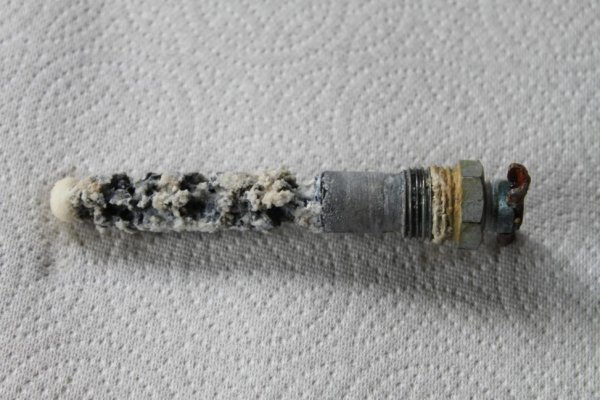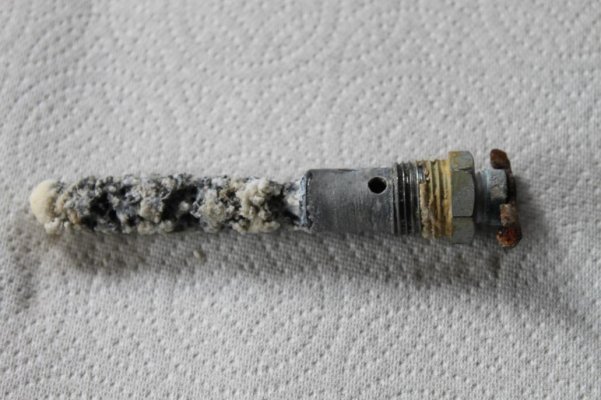A short time ago, someone, possibly Rich, mentioned that there are water heater plugs with finger petcock drains that could be installed in place of the nylon plug that Atwood heaters have as OEM equipment.
Well, a few years ago, I think maybe near the end of 2011, I bought and installed a sacrificial anode rod with such a drain. I found it at Ace Hardware.
It seemed to work fine, although the petcock became rusty looking very quickly.
This year, when I opened the petcock, only a small amount to water dribbled out. And, I decided I should probably flush the tank with my tank cleaner wand that I bought some time ago and have never used. Sometimes, my brilliance astonishes me.
Sometimes, my brilliance astonishes me.
So, I removed the plug and rod assembly and you can see from the pictures, it has certainly suffered. Additionally, at least two gallons of water (maybe even more) gushed out of the drain with the plug removed. I think I was lucky to have removed it now. Clearly, the petcock drain was blocked and you can see the anode rod is in danger of falling apart. Yow! There are two small holes near the threads (you can see one in the second picture) that are there for draining purposes. They won't allow any large particles to pass through, so sediment could easily build up in the tank.
I recalled that shortly after I installed the anode rod, I read somewhere that it was not a good idea to do so in Atwood water heaters (the brand that's in my trailer). I sort of "ignored" that advice then (obviously) so today I did a search for information on using this product. I came up quickly with these two links:
https://www.rv.net/forum/index.cfm/fuseaction/thread/tid/24754779/print/true.cfm
http://www.hilotrailerforum.com/f17/water-heater-brands-1835/
I think it was the second source that I read then, in our very own forum.
Anyway, I've decided I'm through with anode rods and metal plugs. I still have the nylon plug (I never throw anything useful away) and it will be going back into my heater.
- Jack
Well, a few years ago, I think maybe near the end of 2011, I bought and installed a sacrificial anode rod with such a drain. I found it at Ace Hardware.
It seemed to work fine, although the petcock became rusty looking very quickly.
This year, when I opened the petcock, only a small amount to water dribbled out. And, I decided I should probably flush the tank with my tank cleaner wand that I bought some time ago and have never used.
So, I removed the plug and rod assembly and you can see from the pictures, it has certainly suffered. Additionally, at least two gallons of water (maybe even more) gushed out of the drain with the plug removed. I think I was lucky to have removed it now. Clearly, the petcock drain was blocked and you can see the anode rod is in danger of falling apart. Yow! There are two small holes near the threads (you can see one in the second picture) that are there for draining purposes. They won't allow any large particles to pass through, so sediment could easily build up in the tank.
I recalled that shortly after I installed the anode rod, I read somewhere that it was not a good idea to do so in Atwood water heaters (the brand that's in my trailer). I sort of "ignored" that advice then (obviously) so today I did a search for information on using this product. I came up quickly with these two links:
https://www.rv.net/forum/index.cfm/fuseaction/thread/tid/24754779/print/true.cfm
http://www.hilotrailerforum.com/f17/water-heater-brands-1835/
I think it was the second source that I read then, in our very own forum.
Anyway, I've decided I'm through with anode rods and metal plugs. I still have the nylon plug (I never throw anything useful away) and it will be going back into my heater.
- Jack



